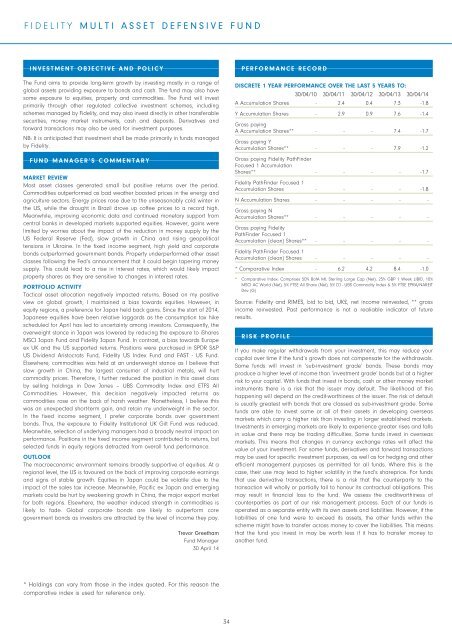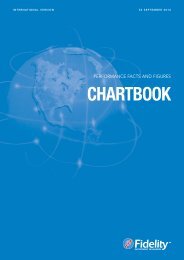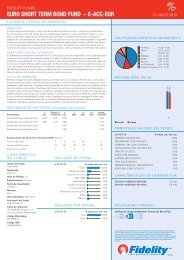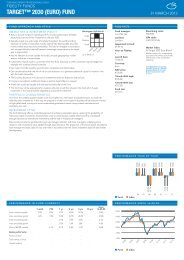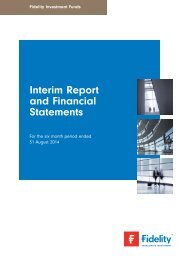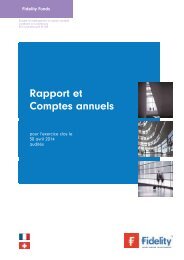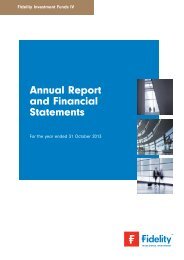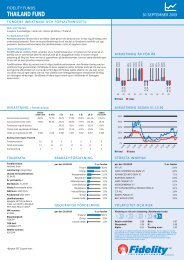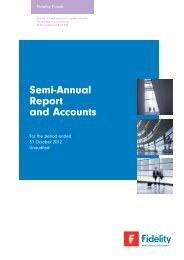Semi-Annual Reports and Accounts - Fidelity Worldwide Investment
Semi-Annual Reports and Accounts - Fidelity Worldwide Investment
Semi-Annual Reports and Accounts - Fidelity Worldwide Investment
You also want an ePaper? Increase the reach of your titles
YUMPU automatically turns print PDFs into web optimized ePapers that Google loves.
FIDELITY MULTI ASSET DEFENSIVE FUNDINVESTMENT OBJECTIVE AND POLICYThe Fund aims to provide long-term growth by investing mostly in a range ofglobal assets providing exposure to bonds <strong>and</strong> cash. The fund may also havesome exposure to equities, property <strong>and</strong> commodities. The Fund will investprimarily through other regulated collective investment schemes, includingschemes managed by <strong>Fidelity</strong>, <strong>and</strong> may also invest directly in other transferablesecurities, money market instruments, cash <strong>and</strong> deposits. Derivatives <strong>and</strong>forward transactions may also be used for investment purposes.NB: It is anticipated that investment shall be made primarily in funds managedby <strong>Fidelity</strong>.FUND MANAGER’S COMMENTARYMARKET REVIEWMost asset classes generated small but positive returns over the period.Commodities outperformed as bad weather boosted prices in the energy <strong>and</strong>agriculture sectors. Energy prices rose due to the unseasonably cold winter inthe US, while the drought in Brazil drove up coffee prices to a record high.Meanwhile, improving economic data <strong>and</strong> continued monetary support fromcentral banks in developed markets supported equities. However, gains werelimited by worries about the impact of the reduction in money supply by theUS Federal Reserve (Fed), slow growth in China <strong>and</strong> rising geopoliticaltensions in Ukraine. In the fixed income segment, high yield <strong>and</strong> corporatebonds outperformed government bonds. Property underperformed other assetclasses following the Fed’s announcement that it could begin tapering moneysupply. This could lead to a rise in interest rates, which would likely impactproperty shares as they are sensitive to changes in interest rates.PORTFOLIO ACTIVITYTactical asset allocation negatively impacted returns. Based on my positiveview on global growth, I maintained a bias towards equities. However, inequity regions, a preference for Japan held back gains. Since the start of 2014,Japanese equities have been relative laggards as the consumption tax hikescheduled for April has led to uncertainty among investors. Consequently, theoverweight stance in Japan was lowered by reducing the exposure to iSharesMSCI Japan Fund <strong>and</strong> <strong>Fidelity</strong> Japan Fund. In contrast, a bias towards Europeex UK <strong>and</strong> the US supported returns. Positions were purchased in SPDR S&PUS Dividend Aristocrats Fund, <strong>Fidelity</strong> US Index Fund <strong>and</strong> FAST - US Fund.Elsewhere, commodities was held at an underweight stance as I believe thatslow growth in China, the largest consumer of industrial metals, will hurtcommodity prices. Therefore, I further reduced the position in this asset classby selling holdings in Dow Jones – UBS Commodity Index <strong>and</strong> ETFS AllCommodities. However, this decision negatively impacted returns ascommodities rose on the back of harsh weather. Nonetheless, I believe thiswas an unexpected short-term gain, <strong>and</strong> retain my underweight in the sector.In the fixed income segment, I prefer corporate bonds over governmentbonds. Thus, the exposure to <strong>Fidelity</strong> Institutional UK Gilt Fund was reduced.Meanwhile, selection of underlying managers had a broadly neutral impact onperformance. Positions in the fixed income segment contributed to returns, butselected funds in equity regions detracted from overall fund performance.OUTLOOKThe macroeconomic environment remains broadly supportive of equities. At aregional level, the US is favoured on the back of improving corporate earnings<strong>and</strong> signs of stable growth. Equities in Japan could be volatile due to theimpact of the sales tax increase. Meanwhile, Pacific ex Japan <strong>and</strong> emergingmarkets could be hurt by weakening growth in China, the major export marketfor both regions. Elsewhere, the weather induced strength in commodities islikely to fade. Global corporate bonds are likely to outperform coregovernment bonds as investors are attracted by the level of income they pay.Trevor GreethamFund Manager30 April 14PERFORMANCE RECORDDISCRETE 1 YEAR PERFORMANCE OVER THE LAST 5 YEARS TO:30/04/10 30/04/11 30/04/12 30/04/13 30/04/14A Accumulation Shares - 2.4 0.4 7.3 -1.8Y Accumulation Shares - 2.9 0.9 7.6 -1.4Gross payingA Accumulation Shares** - - - 7.4 -1.7Gross paying YAccumulation Shares** - - - 7.9 -1.2Gross paying <strong>Fidelity</strong> PathFinderFocused 1 AccumulationShares** - - - - -1.7<strong>Fidelity</strong> PathFinder Focused 1Accumulation Shares - - - - -1.8N Accumulation Shares - - - - -Gross paying NAccumulation Shares** - - - - -Gross paying <strong>Fidelity</strong>PathFinder Focused 1Accumulation (clean) Shares** - - - - -<strong>Fidelity</strong> PathFinder Focused 1Accumulation (clean) Shares - - - - -* Comparative Index - 6.2 4.2 8.4 -1.0* Comparative Index: Comprises 50% BofA ML Sterling Large Cap (Net), 25% GBP 1 Week LIBID, 10%MSCI AC World (Net), 5% FTSE All Share (Net), 5% DJ - UBS Commodity Index & 5% FTSE EPRA/NAREITDev (G)Source: <strong>Fidelity</strong> <strong>and</strong> RIMES, bid to bid, UK£, net income reinvested, ** grossincome reinvested. Past performance is not a realiable indicator of futureresults.RISK PROFILEIf you make regular withdrawals from your investment, this may reduce yourcapital over time if the fund’s growth does not compensate for the withdrawals.Some funds will invest in ‘sub-investment grade’ bonds. These bonds mayproduce a higher level of income than ‘investment grade’ bonds but at a higherrisk to your capital. With funds that invest in bonds, cash or other money marketinstruments there is a risk that the issuer may default. The likelihood of thishappening will depend on the credit-worthiness of the issuer. The risk of defaultis usually greatest with bonds that are classed as sub-investment grade. Somefunds are able to invest some or all of their assets in developing overseasmarkets which carry a higher risk than investing in larger established markets.<strong>Investment</strong>s in emerging markets are likely to experience greater rises <strong>and</strong> fallsin value <strong>and</strong> there may be trading difficulties. Some funds invest in overseasmarkets. This means that changes in currency exchange rates will affect thevalue of your investment. For some funds, derivatives <strong>and</strong> forward transactionsmay be used for specific investment purposes, as well as for hedging <strong>and</strong> otherefficient management purposes as permitted for all funds. Where this is thecase, their use may lead to higher volatility in the fund’s shareprice. For fundsthat use derivative transactions, there is a risk that the counterparty to thetransaction will wholly or partially fail to honour its contractual obligations. Thismay result in financial loss to the fund. We assess the creditworthiness ofcounterparties as part of our risk management process. Each of our funds isoperated as a separate entity with its own assets <strong>and</strong> liabilities. However, if theliabilities of one fund were to exceed its assets, the other funds within thescheme might have to transfer across money to cover the liabilities. This meansthat the fund you invest in may be worth less if it has to transfer money toanother fund.* Holdings can vary from those in the index quoted. For this reason thecomparative index is used for reference only.34


